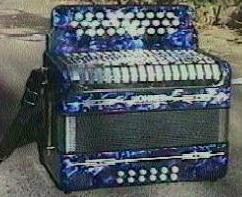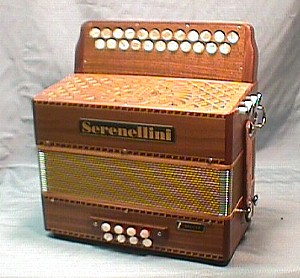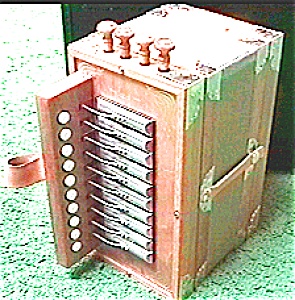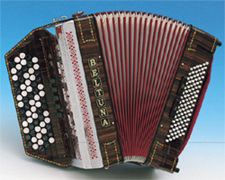 |
Some Basic Three Row Accordion Facts.
There are many different button accordion configurations so before you start you should
be sure that you are playing an accordion that is appropriate for the type of music that you want to play, in this case Tex-Mex,
Norteña, Conjunto, Tejano music.
| Standard Three Row Diatonic Accordion |

|
| Standard Two Row Diatonic Accordion |

|
| One Row Diatonic Accordion for Zydeco Cajun |

|
| Chromatic Accordion or Bayan |

|
The most appropriate accordion for Tejano, Tex Mex, Norteña or Conjunto music is the three row Diatonic
accordion, which comes in four different tunings, La (ADG), Sol (GCF), Fa (FBbEb) and Mi (EAD).
Each row of a three row
button accordion represents a scale.
The row farthest from the bellows is G. The middle row is C and the row
closest to the bellows is F.
For the purposes of this site we will use a numbering system to
show you where to put
your fingers. If we say F3 you should put your finger on the third button of the F row.
F3C6 would be the third button
of the F row and the sixth button of the C row.
The same notation but within brackets [F3C6] would mean to play these notes
while closing the bellows. If no brackets appear, play theses notes while opening. (the majority of the Tex-Mex
style is played while opening the bellow.
If there are single notes on the same line we will just note the row
once:
F3,4,5 6 etc. This would mean playing the 3,4,5,6th note on the
F row.
All phrases are broken up by commas.
One point to remember as you learn the 3- row - Diatonic Button Accordion is that the music commonly played on this
instrument is a type of Folk Music. The musicians who developed this music over the years were not studying in a conservatory
or an academy of music. They were learning by ear and passing down the culture of this music from generation to generation.
Therefore, you may find certain concepts which use a very specific terminology which is exclusive to this instrument and style.
These terms could clash with "Classical Music Terminology." Wherever possible I will try to make it clear where there
is a difference between Tex - Mex concepts and regular music concepts.
|